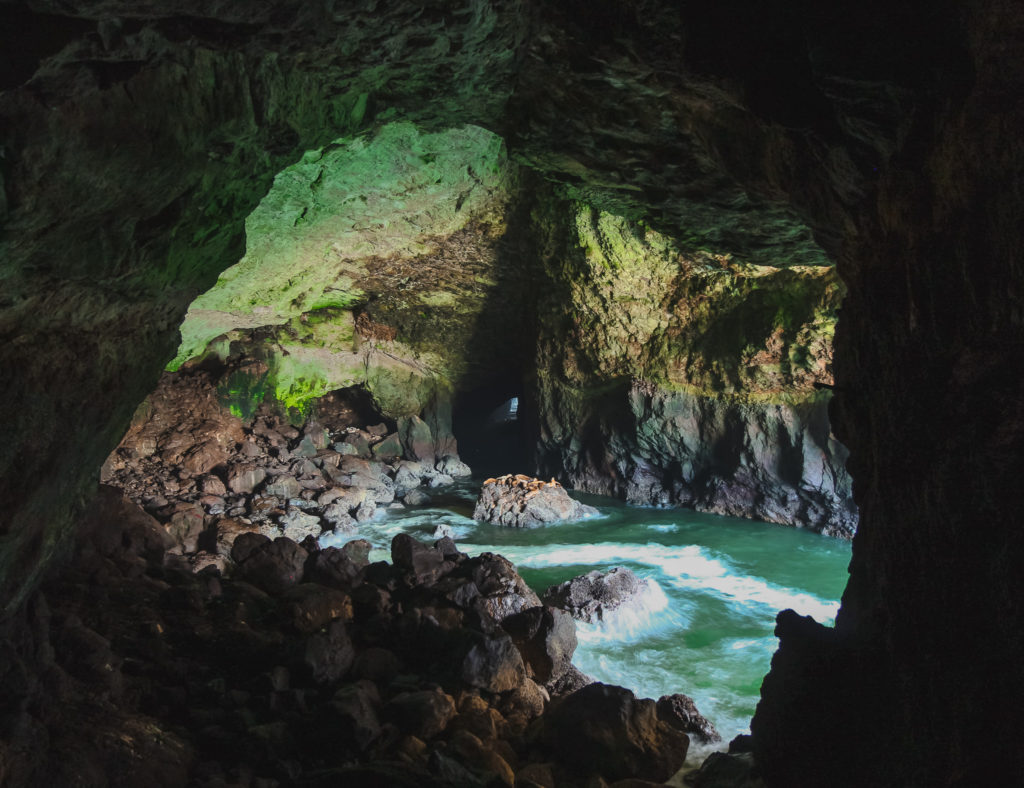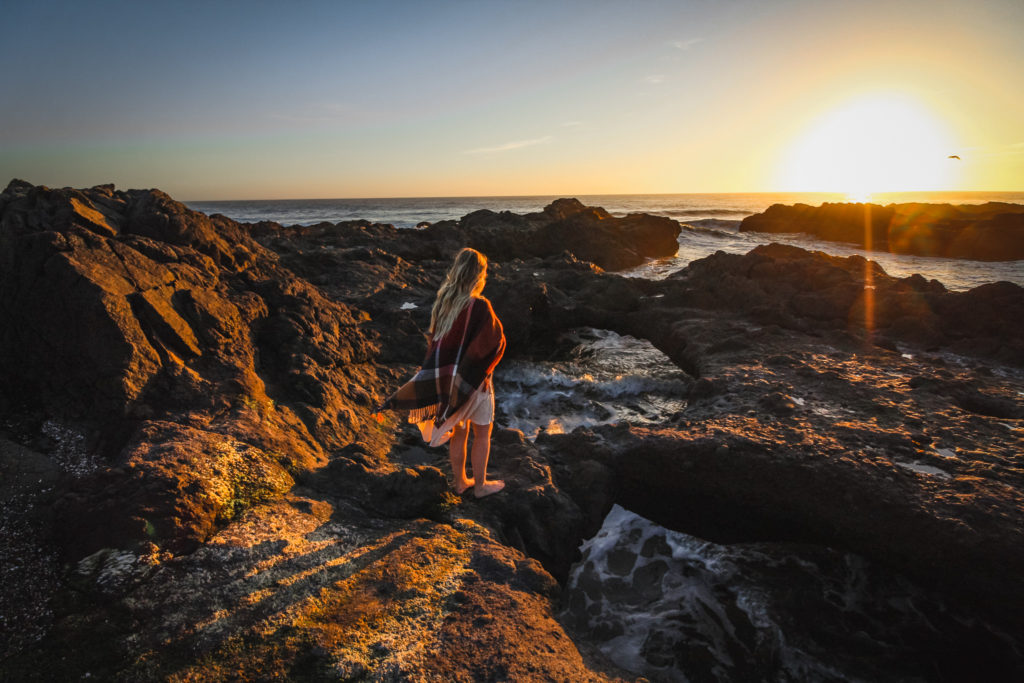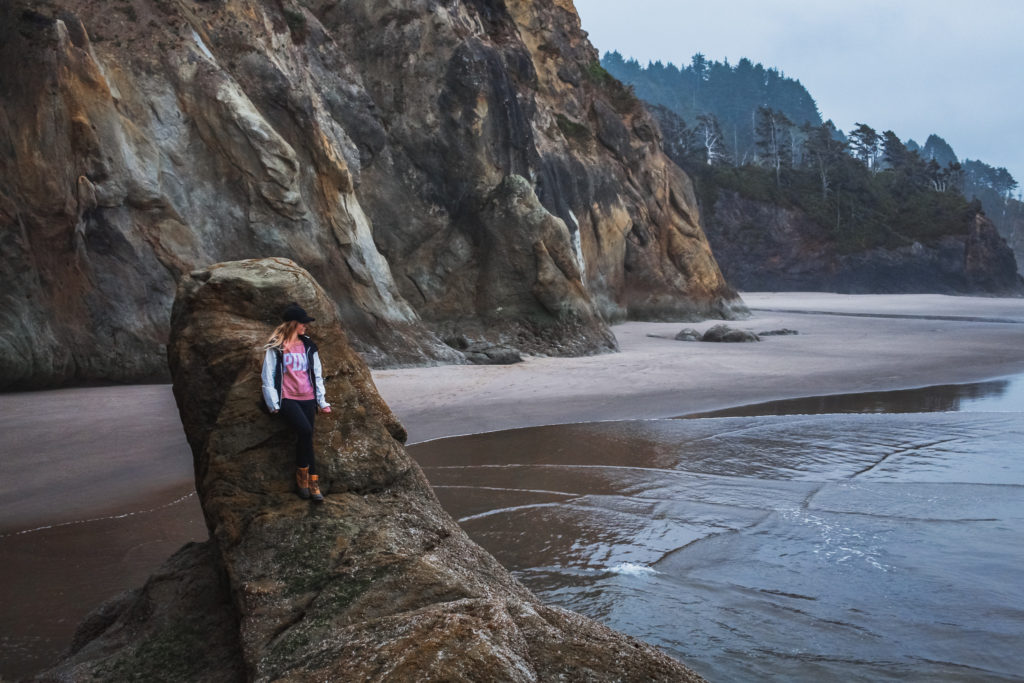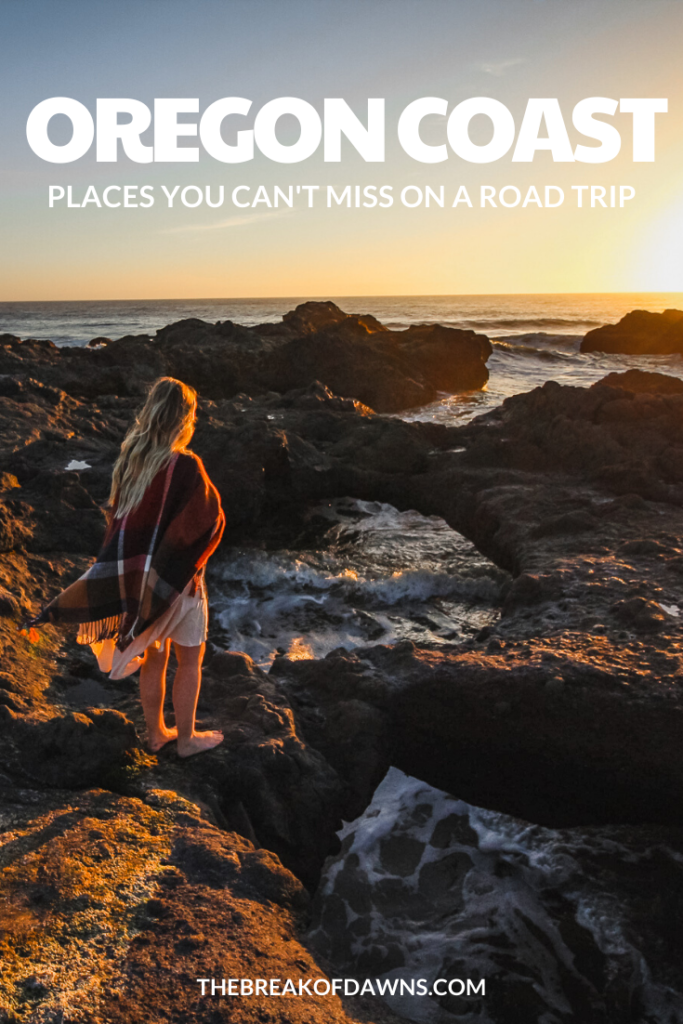
Hazy mist rolls in over a sandy beach, complemented by lush evergreens and decorating the bluffs that hug the Pacific. That scene can directly describe one of my favorite states, Oregon. Making my way north to Washington from California, I drove the 400 miles of the Oregon Coast Highway, stopping at the best stops along the way.
Here’s the Oregon Coast Highway – Top Stops Along the Way:

Samuel H. Boardman Scenic Corridor
Probably my favorite spot on the entire Oregon Coast Highway is just across the border from California. While it only spans a total of 12 miles, the Samuel H. Boardman Scenic Corridor is hands down one of the most gorgeous spots on the entire North American west coast.
Head out on the coastal trail that dips in and out of forests and to epic viewpoints. All of the main lookouts are posted along the Oregon Coast Highway so you shouldn’t miss a thing!

Oregon Dunes at Gardiner
The massive Oregon Dunes along the coastline are more than just your average sandy beach. Stretching 40 miles in total, the sand knolls are a result of millions of years of wind and rain erosion. These aren’t just small beach hills either, some rise as as high as 500 feet!
Check out the dunes by renting an ATV or dune buggy nearby. Another worthy time to visit is sunset to see the colors roll in over the mounds.

Sea Lion Caves in Florence
About halfway up the coast of Oregon is a natural marine sanctuary, drawing visitors since the 1932 opening. The sea lion caves are the only known mainland home of the Steller’s species. Hundreds of sea lions constantly come to this spot to escape the cold waters of the Pacific. Take an elevator down 208 feet to see the 25 million year old cave. The observation deck nearby overlooks them on the bluffs below and is a good place to see the whale migration.
Check the hours and current admission prices for the sea lion caves here.

Heceta Head Lighthouse
The most photographed lighthouse in the world has been illuminating the Oregon coast for over a century. In fact, the Heceta Head Lighthouse is the brightest light on the west coast, seen from 25 miles away. Sitting on the edge of the Pacific at 200 feet high, the lighthouse is a part of a 550-acre state park. Before electricity, keepers had to tend to the light every 2 hours throughout the night. In 1963, the lighthouse became fully automated, eliminating the need for manual lightings. The old home for the keeper was turned into a bed and breakfast.
Visit Heceta Head to see why it’s a National Historic Monument. Hike the scenic trails along the coast or head down to Heceta Beach for some wildlife viewing.

Thor’s Well
While the nearby Sprouting Horn and Devil’s Churn are popular, Thor’s Well is the real top stop on the Oregon coast. This sort of sinkhole (nobody really knows exactly what to call it) fills with water all the way to the top, spilling out onto the basalt rock around it, then drains back down in a whirlpool motion. At 20 feet deep, most geologists believe that it was once a sea cave until the roof collapsed. Thor’s Well is a popular place for photographers during the high tide; the splashing waves over the rock make for a stunning sight.

Yaquina Bay
A channel in the town of Newport, Yaquina Bay is a popular tourist stop on the Oregon Coast Highway. The bustling oyster and clam businesses drew hundreds of people to this area in the 1800s. Because it’s halfway between San Francisco and Seattle, the town began as a main shipment and navigation port. The vibe here is similar to San Fran’s wharf with chowder stands, tourist attractions and docks for the sea lions.

Make a pit stop in Yaquina Bay to visit the popular spots. See the stunning Bay Bridge that the Oregon Coast Highway crosses over. Spend a day on the sandy beaches or stroll around the historic lighthouse, built in the 1870s.
Tillamook County
You don’t have to be in Wisconsin to get some old-fashioned homemade cheese. Tillamook County is known for their dairy, more specifically their cream. These products are actually found in grocery stores throughout the country. Head over to the Tillamook Creamery for a classic grilled cheese sandwich and mac ‘n cheese. You may even decide to stay the night in Tillamook. If you do, camp out in an old covered wagon like we did, a cool way to wake up on the Oregon coast.

Oregon Coast Scenic Railroad in Garibaldi
One of my favorite little stops on the Oregon Coast Highway is Garibaldi. This old lumber town nestled in Tillamook Bay has a picturesque marina and old remnants of past logging companies. Now it’s the main hub for the Oregon Coast Scenic Railroad that runs between here and other coastal towns. Prior to the railroad connecting these towns in 1912, people would have to travel from Portland by wagon on a coastal trail, taking no less than 2 weeks.
Tickets for the rail are quite cheap and a popular thing to do in the summer months. If you don’t choose to take a ride, at least come to the train station to watch the old steam engines take off with the lush-evergreened hillsides as the backdrop.

The Original Pronto Pup
In the 1930s, a husband and wife team from Rockaway Beach made a living by selling hot dogs from their vendor stand. After the buns were ruined in the rain, the husband thought it’d be smart to cook them as needed, creating a pancake batter to dip them in. While some claim that the corn dog originated elsewhere, this is the oldest record of the carnival snack being made.
Stop in to Pronto Pup Thursday through Sunday to snag your own original corn dog.

Rockaway Beach
This adorable century-old little town off the Oregon Coast Highway began as a seaside resort by New York’s Rockaway Beach Company. Monstrously wide with 7 miles of shoreline, the main street of shops and the uniquely colored buildings make it a popular tourist area. The most iconic sight of Rockaway Beach is the Twin Rocks, pictured here. After millions of years of erosion, these rocks have drifted apart from one another and from the coast of Oregon where they now sit idly out in the Pacific.

Hug Point
Hug Point is a state recreation site, fee-free and an awesome place to stop along the Oregon Coast Highway. 19th century stagecoaches would use Oregon’s beaches as their highways and here, at low tide, the travelers would have to “hug” the edge to get around the bend.

Historians also believe that many wagons were swept out to the ocean in this spot. Someone, whose identity is still unknown, etched a sort of roadway into the edge of the cliff where visitors today can walk on and around to another beach.

Various sea caves can be explored here but do so cautiously as the tide tends to come in very quickly. Walking around the edge of the cliff head, low tide pools reveal some neat marine life like sea stars and anemones.

Cannon Beach & Haystack Rock
You may have seen this stunning place pictured once or twice, as it represents one of Oregon’s most iconic landmarks. 15 million years ago, the lava flow coming down the coastline created Haystack Rock, which was once adjoined by the coast. Years of erosion from rain, sea water and wind have forced it out into the ocean. Standing at 327 feet above sea level, Haystack Rock is the 4th tallest off-shore sea stack in the world. At low tide, visitors can walk all the way out to Haystack Rock to see the tidal pools that hold sea anenomes, crabs and starfish. Tufted puffins use the rock as their habitat for 4 months out of the year and are a protected species here.

Peter Iredale Shipwreck
At the most northwest point of Oregon in Fort Stevens State Park is what’s left of a 285 foot long ship, the Peter Iredale. In 1906, Captain Lawrence and his crew of 27 were sailing from Mexico to Portland via the Columbia River when heavy winds pushed the ship ashore at Clatsop Split. Plans were made to eventually haul the ship back to sea, as no real damage was done during the wreck, but unfavorable weather and ocean conditions delayed the tow, with which the ship became embedded into the sand where it still remains today.

Lewis & Clark National Historical Park
In 1805, the expedition of Lewis and Clark reached their final destination at the Pacific Ocean. After staying on the Washington side of the Columbia River, the group, including Sacagawea, took a vote to move to the Oregon side on a suggestion by the Clatsop Indians. Since the snow and treacherous winter conditions would delay their trek back east, they built Fort Clatsop in a matter of weeks, where they spent the winter between 1805 and 1806.

There are various historical markers throughout the park, including the replica of Fort Clatsop, the creeks with which the adventurers got their fresh water, and the forests where they hunted for elk and deer to sustain themselves during the winter months.
Astoria
The gateway to Washington begins here in Astoria. With the road passing over the 4 mile Astoria-Megler Bridge, Astoria a top stop on the Oregon Coast Highway.
Fort Astoria was established in 1811 after an investor from New York City brought his American Fur Company here. It was the first permanent settlement on the Pacific and it also contained the first U.S. Post Office west of the Rocky Mountains. The decline of Astoria is directly attributed to the growth of larger cities on the coast like Seattle, Portland and San Francisco. Many companies have shut down or moved elsewhere since the establishment but the town remains as a popular tourist spot for its convenient location at the mouth of the Columbia River.

Read More Oregon Travel Posts Here
Like This Post? Pin It!
| This post contains affiliate links which means that, at no extra cost to you, if you purchase one of these products I may receive a small commission. This helps me maintain my blog as a free space to you. Check out my Disclaimer for more info.






Great travel tips! Can’t wait to go to Oregon one day
Thank you! And I hope you do, such beautiful country out there! 🙂